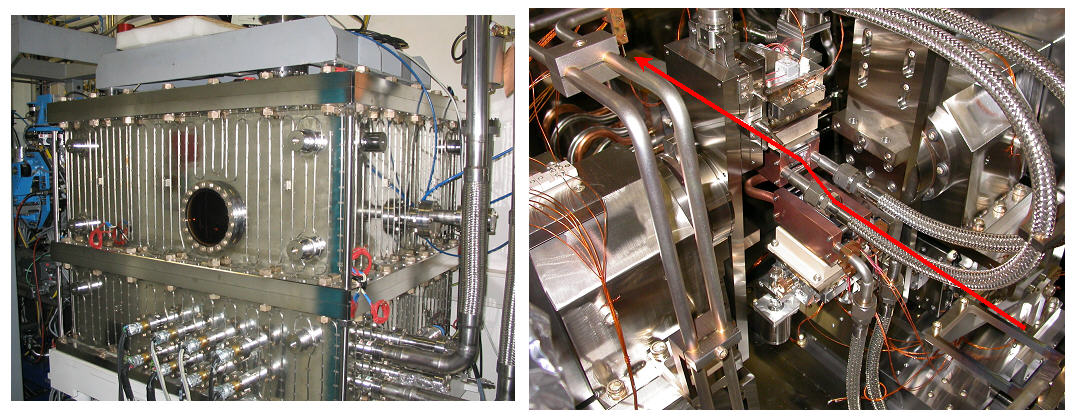- Home
- Users & Science
- Find a beamline
- Matter at extremes
- ID14 - Nuclear Resonance Beamline
- Beamlines layout and performance
- Optics elements
- High Heat-Load Monochromator
High Heat-Load Monochromator

The design of the high heat-load monochromator is governed by the following demands:
- short and long term angular stability
- high accuracy and resolution of angular positioning
- reliable energy defining element
- fixed exit
- matching of the divergence of the source and the angular acceptance of the monochromator
- preservation of ideal propagation of the x-ray wave field
Based on these demands a fixed exit liquid nitrogen cooled high heat-load monochomator was designed consisting of two separate Si(111) crystals on two separate mechanics. The first crystal is mounted on a horizontal translation stage to allow for fixed exit operation. The second one is equipped with a high resolution encoder system and defines the chosen energy. The crystals are cut slightly asymmetric to match the divergence of the x-ray beam up to 27 keV. Tilt stages allow for crystal alignment. The offset between incoming and outgoing beam is 25mm allowing for an energy range 6 to 68 keV with the Si(111) reflection. The monochromator has been purchased from KOHZU, Japan.
The monochromator operates at UHV conditions (10-8 mbar). Besides that, the KOHZU mechanics provides perfect angular resolution (100 nrad) and angular stability (mean deviation of about 1 urad per month). This improved the energy stability of the monochromatized beam (mean deviation of about 0.3 eV per month). Due to the efficient cooling, proper thermal isolation, and shielding of the second crystal, the monochromator has no "transition time" after refill: it provides a proper flux at proper energy next minute after the beam is back to user mode (see Figure).

(Left) Time evolution of the x-ray intensity after the high heat-load monochromator in comparison to the storage ring current history. Note any absence of a transient period after refill. (Right) A sequence of several rocking curves performed with the first crystal of the high heat-load monochromator during a period of 10 hours. The thermal drift of the crystals induced by a variation of heat load does not exceed 0.34 urad.
Additional information:
A. I. Chumakov, I. Sergeev, J.-P. Celse, R. Rüffer, M. Lesourd, L. Zhang and M. Sánchez del Río - Performance of a silicon monochromator under high heat load - J. Synchrotron Rad. 21 (2014) 315-324
Aleksandr I. Chumakov, Rudolf Rüffer, Olaf Leupold, Jean-Philippe Celse, Keith Martel, Michel Rossat, and Wah-Keat Lee. Performance of a cryogenic silicon monochromator under extreme heatload. Journal of Synchrotron Radiation, 11 (2004) 132--141.



